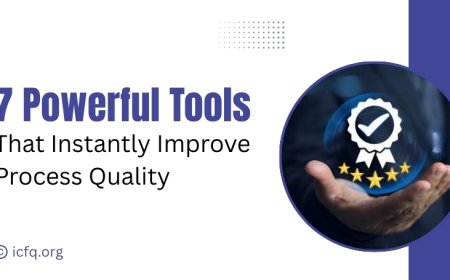Six Sigma Green Belt Key Tools and Techniques
Learn how to improve efficiency with Six Sigma Green Belt! Discover simple tools to make processes better and boost quality.

In business process improvement, the Six Sigma Green Belt stands out as a crucial certification for professionals aiming to enhance operational efficiency and quality. This certification, a vital part of the broader Six Sigma concept, equips individuals with the knowledge and skills needed to lead projects and drive significant improvements within an organization. The Six Sigma Green Belt plays a pivotal role, in bridging the gap between basic understanding and advanced mastery found in Six Sigma Yellow Belt and Six Sigma Black Belt certifications.
Six Sigma Courses, including Lean Six Sigma Courses, provide a comprehensive understanding of the methodologies and tools essential for process improvement. These courses cover a wide range of topics from basic principles to advanced techniques, ensuring that participants are well-prepared to tackle real-world challenges. Six Sigma Certification, particularly the Six Sigma Green Belt, is highly valued in industries worldwide for its emphasis on data-driven decision-making and process optimization.
With the rise of Six Sigma Online Courses, obtaining a Six Sigma Green Belt has never been more accessible. These programs offer flexibility and convenience, allowing professionals to balance their career development with other commitments. Aspiring candidates can progress to advanced levels such as Six Sigma Black Belt and Six Sigma Master Black Belt, solidifying their expertise and leadership in Six Sigma Programs.
The Successful Six Sigma Green Belt Projects
Six Sigma Green Belt projects play a crucial role in helping companies improve their operations and save money. These projects are led by people who have been trained and certified in Six Sigma methods, and they focus on analyzing data, solving problems, and making smart decisions. The goal of Six Sigma Green Belt projects is to make processes work better and reduce mistakes. This is important because even small improvements can add up to big savings for a company. By finding and fixing problems, Six Sigma Green Belts helps their companies run more smoothly and efficiently.
Success in Six Sigma Green Belt projects is important for businesses because it shows that they are committed to doing their best work. It's not just about fixing one thing—it's about always looking for ways to do better. By investing in Six Sigma training and certification, companies can build a team of people who are experts in finding and fixing problems. Six Sigma Green Belt projects are part of a larger effort to make businesses better. They help create a culture where everyone is always looking for ways to improve. By training people at all levels of the organization, from Six Sigma Green Belts to Black Belts to Yellow Belts, companies can make sure that everyone is working together to achieve their goals.
The Challenges of Learning Six Sigma Green Belt Tools
When you're learning about Six Sigma Green Belt techniques, you're in for a ride full of obstacles. While becoming an expert in these methods offers great benefits, the journey to mastery can be tricky and might discourage even the most determined learners. Let's break down these challenges:
1. Tools Are Complicated: Six Sigma Green Belt has a bunch of tools, like Pareto charts and control charts. Each tool has its own rules and can be pretty confusing at first.
2. Understanding Data Is Tough: Six Sigma Green Belt relies a lot on looking at data to make decisions. However understanding data correctly can be hard, especially for beginners. If you misinterpret the data, you might end up with the wrong solutions.
3. Applying Skills in Real Life: Learning about the Six Sigma Green Belt in theory is one thing, but using it in real life is another. Things like different situations, unexpected problems, and how your organization works can make it harder to use these tools properly.
4. People Don't Like Change: Trying to use the Six Sigma Green Belt often means changing how things are done in your organization. But not everyone likes change, and that can slow things down. Getting everyone on board and open to change takes good leadership and communication.
5. Not Enough Resources: You need enough time, money, and people to use the Six Sigma Green Belt effectively. But sometimes, there just aren't enough resources. Balancing what you have with what you need for your projects is important.
6. Keeping the Progress Going: Getting some early wins with Six Sigma Green Belt is great, but keeping that momentum going is hard. You have to keep everyone interested, keep an eye on how things are going, and deal with any problems that come up.
7. Learning New Skills: Getting good at Six Sigma Green Belt tools means you have to keep learning and practicing. Finding out what you need to learn and getting help when you need it is key to getting better.
Learning Six Sigma Green Belt tools isn't easy, but if you stick with it and tackle these challenges head-on, you can make a big difference in your organization.
What do I need to know to become good at Six Sigma Green Belt?
If you want to ace it as a Six Sigma Green Belt, there are some important tools and techniques you should get familiar with:
1. Start with DMAIC. It's like a roadmap (Define, Measure, Analyze, Improve, Control) that guides you through solving problems step by step.
2. Get comfy with stats. Things like hypothesis testing, regression analysis, and control charts help you make decisions based on data in your projects.
3. Process mapping and flowcharting are handy skills. They help you see how things work, find where things might get stuck, and figure out how to make them run smoother.
4. Ever heard of Fishbone diagrams (also called Ishikawa) or the 5 Whys? These are tools for digging deep into problems to find out what's causing them, not just treating the symptoms.
5. To make sure your products or processes meet what customers want while avoiding problems, you'll want to learn about Quality Function Deployment (QFD) and Failure Mode and Effects Analysis (FMEA).
Tools and Techniques for Six Sigma Green Belts
Being a Six Sigma Green Belt means you're a vital part of making things better in a company. To be good at it, you need to know some important tools and tricks. Let's talk about some of the main ones every Six Sigma Green Belt should know well.
1. Step-by-Step Problem Solving:
Six Sigma has a method called DMAIC: Define, Measure, Analyze, Improve, and Control. It's like a roadmap for fixing things. Green Belts need to know each step and use them to solve problems in projects.
2. Drawing Out Processes:
Process mapping is drawing out how things get done from start to finish. Green Belts uses pictures like flowcharts to find problems and ways to make things smoother.
3. Using Numbers to Understand:
Six Sigma uses numbers a lot. Green Belts should know things like hypothesis testing, which helps to check if changes make a difference, and control charts, which help to keep things on track.
4. Finding the Real Problem:
Root Cause Analysis (RCA) is a way to dig deep and find out why things go wrong. Green Belts use tools like asking "Why?" five times or making diagrams to understand problems better.
5. Making Things Lean:
Lean principles are about cutting out waste to make things faster and better. Green Belts learn about things like mapping out how things flow and keeping workspaces organized to save time and effort.
6. Listening to Customers:
Quality Function Deployment (QFD) is a fancy way to say listening to what customers want. Green Belts uses this to figure out what customers need and make sure projects match those needs.
7. Predicting Problems:
Failure Mode and Effects Analysis (FMEA) is about spotting problems before they happen. Green Belts use it to find ways to stop things from going wrong and keep quality high.
Learning the important tools and techniques of the Six Sigma Green Belt is important for people who want to make things better and run smoothly in businesses. By getting good at these methods, folks can find out where things need improving, reduce mistakes, and make processes work better. With tools like looking at numbers, drawing out how things work, and figuring out why problems happen, Six Sigma Green Belts can lead projects that make a big difference, save resources, and make customers happier. Using these methods, companies can get better at what they do, work more efficiently, and make more money.



























